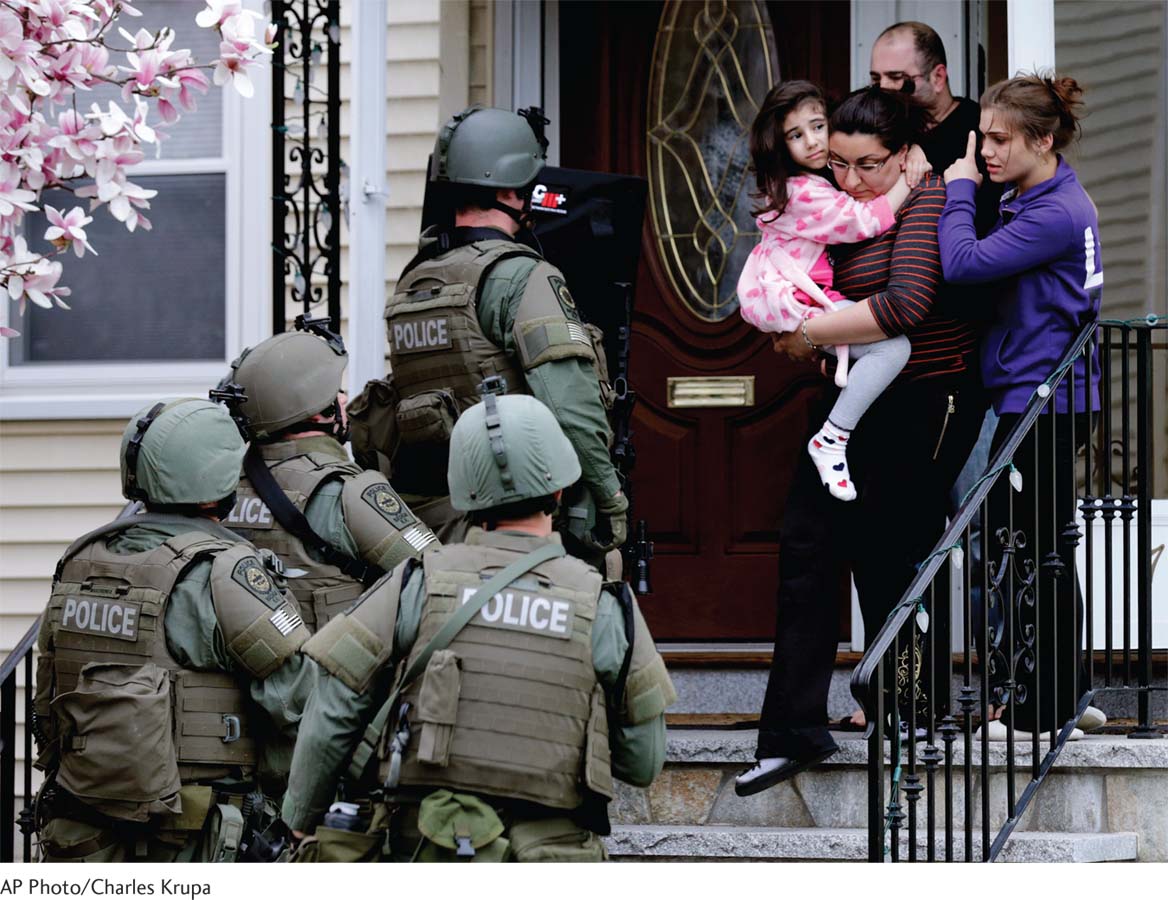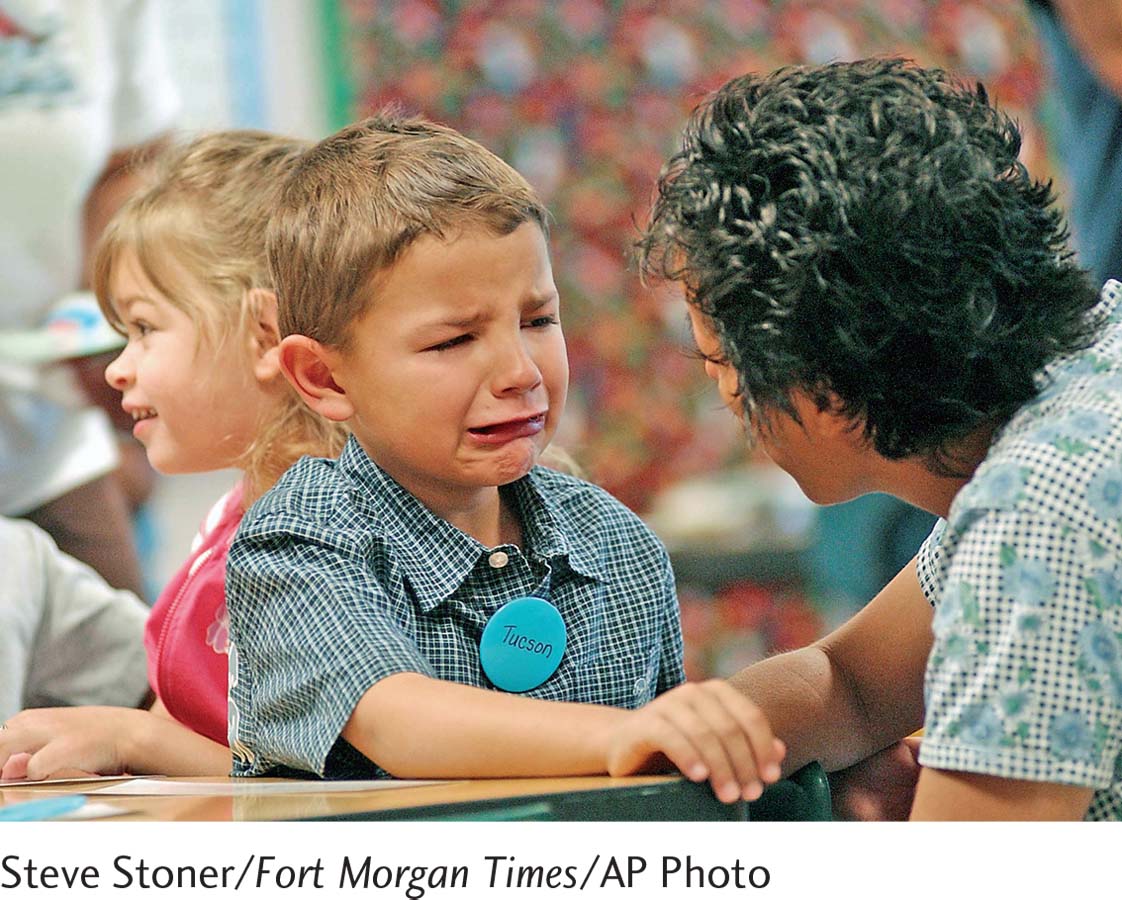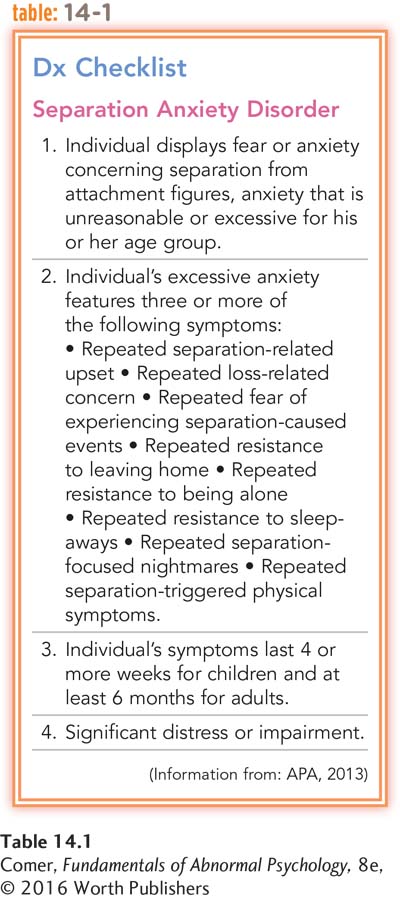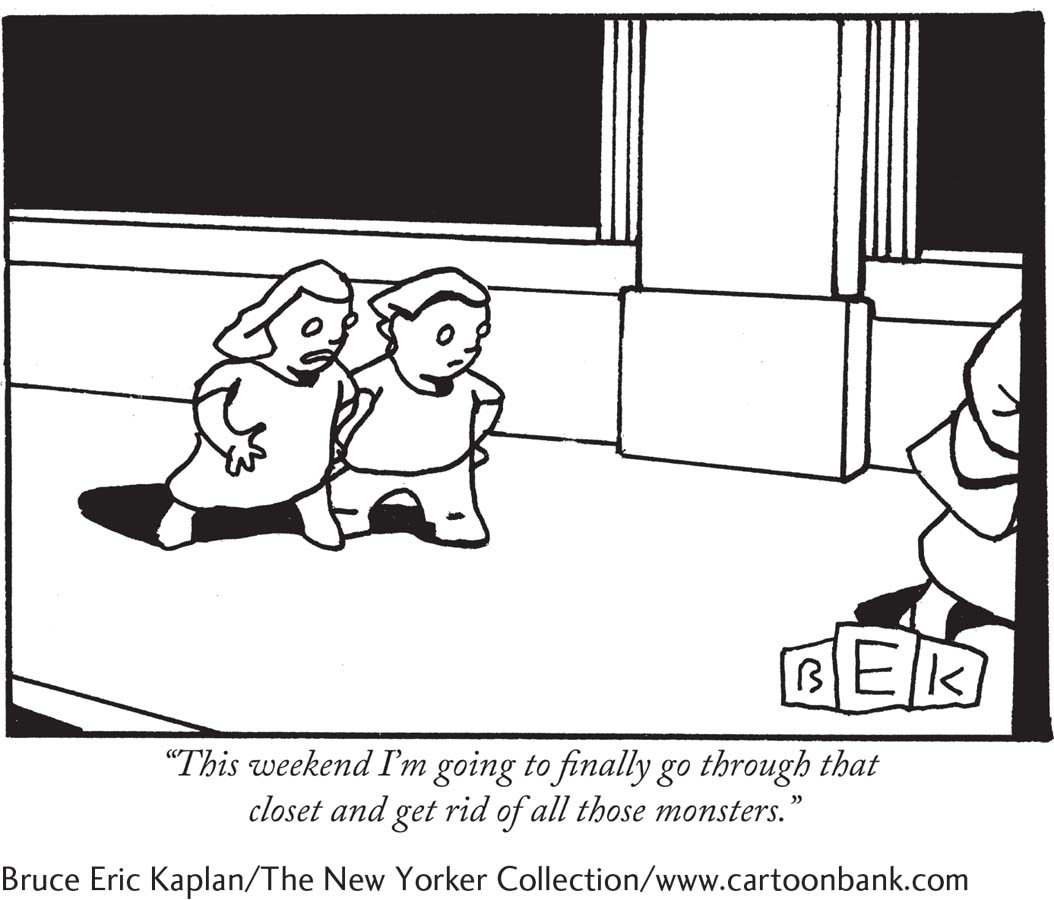14.2 Childhood Anxiety Disorders
Anxiety is, to a degree, a normal part of childhood. Since children have had fewer experiences than adults, their world is often new and scary. They may be frightened by common events, such as the beginning of school, or by special upsets, such as moving to a new house or becoming seriously ill. In addition, each generation of children is confronted by new sources of anxiety. Today’s children, for example, are repeatedly warned, both at home and at school, about the dangers of Internet browsing and networking, child abduction, drugs, and terrorism.
Children may also be strongly affected by parental problems or inadequacies. If, for example, parents typically react to events with high levels of anxiety or if they overprotect their children, the children may be more likely to respond to the world with anxiety (Platt, Williams, & Ginsburg, 2015). Similarly, if parents repeatedly reject, disappoint, or avoid their children, the world may seem an unpleasant and anxious place for them. And if parents are divorced, become seriously ill, or must be separated from their children for a long period, childhood anxiety may result. Beyond such environmental problems, there is genetic evidence that some children are prone to an anxious temperament (Rogers et al., 2013).


InfoCentral
CHILD AND ADOLESCENT BULLYING
Bullying is the repeated infliction of force, threats, or coercion in order to intimidate, hurt, or dominate another—

For some children, anxieties become long-
More often, however, the anxiety disorders of childhood take on a somewhat different character from that of adult anxiety disorders. Typically they are dominated by behavioral and somatic symptoms rather than cognitive ones—
Separation Anxiety Disorder
separation anxiety disorder A disorder marked by excessive anxiety, even panic, whenever the person is separated from home, a parent, or another attachment figure.

Separation anxiety disorder, one of the most common anxiety disorders among children, follows this profile (APA, 2013). The disorder is common (but not unique) to childhood, begins as early as the preschool years, and at least 4 percent of all children experience it (Mash & Wolfe, 2015; APA, 2013). Sufferers feel extreme anxiety, often panic, whenever they are separated from home or a parent. Jonah’s symptoms began when he was a preschooler and continued into kindergarten.
Jonah, age 4, began crying as soon as his parents tried to place him in the car for the 30-
Jonah screamed that he would not get in the car. “I only want to be here with you! If you make me go, I’ll never see you again! What if you like it better without me? What if Granny decides to keep me? What if you die?” Exasperated, Brandon, Jonah’s father, picked up his son and carried him to the car. Jonah cried all the way to his grandparents’ house. At their door, Jonah hugged his mother as though he would never let go.
Jonah finally went inside his grandparents’ house. Eventually, Mia and Brandon left. Two hours later, they received a phone call from Mia’s mother. An inconsolable Jonah had been crying nonstop since his parents had left. Reluctantly, Mia agreed to pick Jonah up, cancelling her and Brandon’s weekend getaway.

That night, Jonah refused to sleep in his own room, insisting on sleeping between his parents. This was something they had tolerated occasionally in the past, but, beginning that night, it became a regular sleeping arrangement. During the next several months, Jonah became hysterical every time Mia or Brandon tried to get him to leave the house for a play date or journey elsewhere.
Five months later, Jonah began kindergarten. That first day lasted all of two hours. The principal called, asking Mia to come get Jonah. Mia was hardly surprised. Her son had cried, screamed, and even kicked the whole ride to school, and his distress only escalated as she drove off. Though sympathetic, the principal explained that Jonah’s nonstop crying was affecting all the other children. “Perhaps tomorrow Jonah will have a better day,” he said. But the next day, Jonah’s reaction was the same. And the next day. And the next day.
Children like Jonah have great trouble traveling away from their family, and they often refuse to visit friends’ houses, go on errands, or attend camp or school (see Table 14.1). Many cannot even stay alone in a room and cling to their parent around the house. Some also have temper tantrums, cry, or plead to keep their parents from leaving them. The children may fear that they will get lost when separated from their parents or that the parents will meet with an accident or illness. As long as the children are near their parents and not threatened by separation, they may function quite normally. At the first hint of separation, however, the dramatic pattern of symptoms may be set in motion.
Separation anxiety disorder may further take the form of a school phobia, or school refusal, a common problem in which children fear going to school and often stay home for a long period (APA, 2013). Many cases of school phobia, however, have causes other than separation fears, such as social or academic fears, depression, and fears of specific objects or persons at school.
Treatments for Childhood Anxiety Disorders
Despite the high prevalence of childhood and adolescent anxiety disorders, around two-

Clinicians have also used drug therapy in a number of cases of childhood anxiety disorders, often in combination with psychotherapy (Mohatt et al., 2014). Drug therapy often appears to be helpful, but it has begun only recently to receive much research attention (Comer et al., 2011, 2010).
play therapy A treatment approach that helps children express their conflicts and feelings indirectly by drawing, playing with toys, and making up stories.
Because children typically have difficulty recognizing and understanding their feelings and motives, many therapists, particularly psychodynamic therapists, use play therapy as part of treatment (Landreth, 2012). In this approach, the children play with toys, draw, and make up stories; in doing so they reveal the conflicts in their lives and their related feelings. The therapists then introduce more play and fantasy to help the children work through their conflicts and change their emotions and behavior. In addition, because children are often excellent hypnotic subjects, some therapists use hypnotherapy to help them overcome intense fears.
Summing Up
CHILDHOOD ANXIETY DISORDERS Emotional and behavioral problems are common in childhood and adolescence. A particular concern among children is that of being bullied. In addition, at least 20 percent of all children and adolescents in the United States have a diagnosable psychological disorder.
Anxiety disorders are particularly common among children and adolescents. This group of problems includes separation anxiety disorder, which is characterized by excessive anxiety, often panic, whenever a child is separated from a parent. Various treatments have been used for children with anxiety disorders, including play therapy.